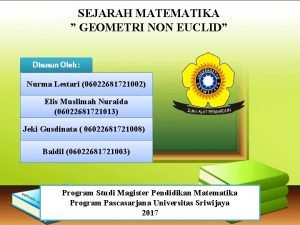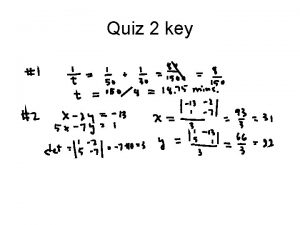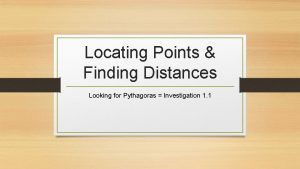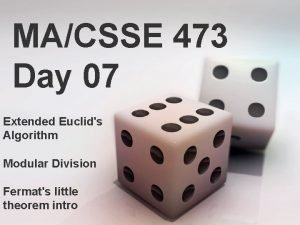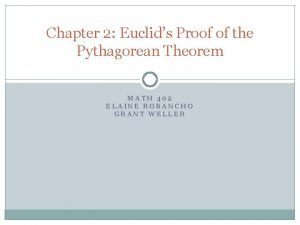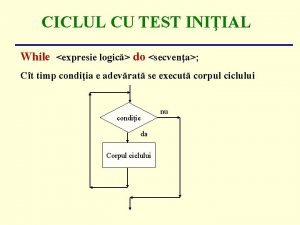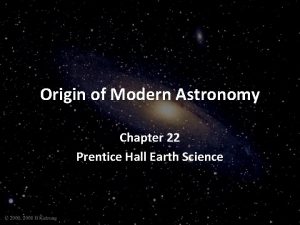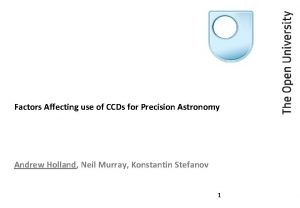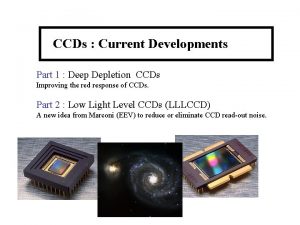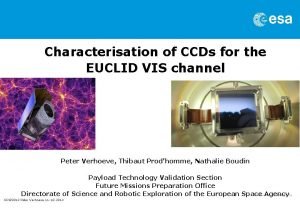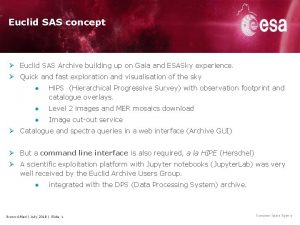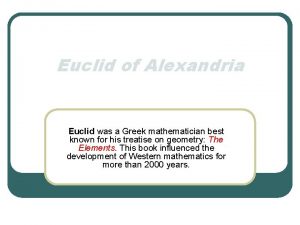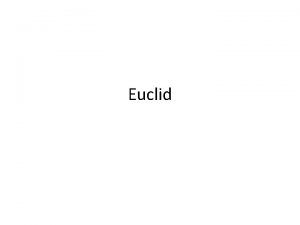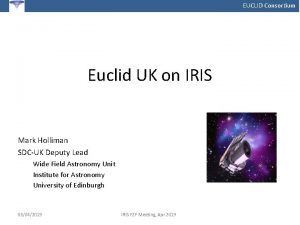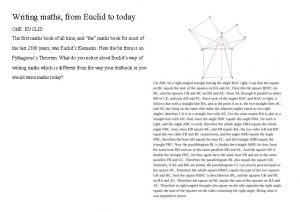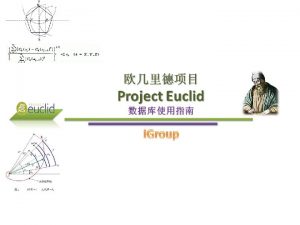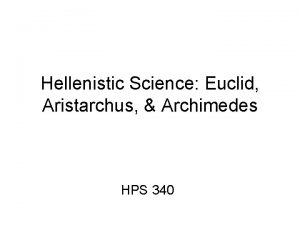Euclid CCDs Douglas Jordan Precision Astronomy with Fully


















- Slides: 18

Euclid CCDs Douglas Jordan Precision Astronomy with Fully Depleted CCDs Brookhaven National Laboratory, December 4 -5, 2014.

Euclid CCDs – Introduction • This presentation will present a summary of the Euclid mission and the requirements of the CCD 273 -84. • Followed by MTF and QE measurements from recently delivered EM (Electrical Model) samples. Slide 2

The Euclid Mission • Euclid is an ESA medium class astronomy and astrophysics space mission. Launch is planned in 2020. • 36 CCD 273 -84 image sensors will make the focal plane of the high quality panoramic visible imager (VIS). • The main task of this instrument is to enable weak lensing measurements. Slide 3

The CCD 273 -84 • The baseline sensor for the mission was e 2 v’s CCD 203 -82 initially developed for NASA’s Solar Dynamics Observatory (SDO) • The CCD 203 -82 is a 4 k x 4 k pixel sensor with each pixel 12 x 12μm. • To optimise the device for Euclid, e 2 v have designed and manufactured the CCD 273 -84 considering the following critical specifications. • High QE at long wavelengths • Tight requirements on PSF. • Close butted package. Slide 4

The CCD 273 -84 vs CCD 203 -82 • This device has a higher-responsivity lower-noise amplifier. • • ~7µV/e- vs ~4µV/e- Enhanced response through the adoption of thicker deep depleted silicon. • 40µm nominal thickness, 1500Ωcm. • Four output ports, each reading out a 2 k x 2 k quadrant of the device. • Further design considerations to mitigate for radiation. Slide 5

Radiation Damage Mitigation • There additional factors to consider when we remember that this device is going into space and as such will be subjected to a radiative environment. • Traps are the main cause of CTE degradation. • Radiation induced traps act on a particular volume so it follows that by reducing the interaction volume, one could reduce the frequency of traps Build the device with a thinner register channel. • Introduce a charge injection structure to fill traps with a “fat zero” prior to readout. Slide 6

Radiation Damage Mitigation • Another undesired impact of the incident ionising radiation is the build-up of charge in the dielectric introducing a flat-band voltage shift. • Electrons readily swept out of the oxide but holes get trapped at one of the interfaces Flat-band voltage shift. • This can seriously affect the operation of the device rendering it unusable within the recommended voltages. • This effect is more pronounced for thicker oxides, so as mitigation, thin -gate technology was adopted. Slide 7

The CCD 273 -84 (front-face sample) Deep Depleted Silicon. 1500Ωcm, 40µm nom. thickness Si. C Package 4Ø Image area (Thin-gate technology) FWC ~ 200 Ke 4096 x 4096 Active, 12µm Pixels 4 x 2 -stage outputs ~2. 5 e-r. m. s Injection Structure Bi-Directional, 3Ø Register FWC ~ 350 Ke 70 KHz Readout Frequency Flexi Connectors to minimize dead space Slide 8

Quantum efficiency Slide 9

Quantum efficiency - red Slide 10

MTF – measurement technique • • • “Pseudo” MTF measured using the vernier technique. A 10µm slit is de-magnified by 20 times and projected on to the device. A gradient of 1 in 8 is used in both serial and parallel directions. Slide 11

MTF – measurement technique • A line response function (LRF) is generated, which is then Fourier transformed to obtain the MTF vs sampling frequency. • This is normalised to 100% at zero frequency. MTF calculated in this way is the total measured MTF • ������ = ������ ×������. �� �� • • Which are the diffusion, geometric and optical MTF components of the system. The results stated in this presentation are presented at Nyquist frequency (1/(2*pixel pitch)) with the optical component of MTF removed. ������. NY= ������ T/������ �� Slide 12

MTF Results from EM deliverables Wavelength (nm) Horizontal MTF (Vertical Slit) Vertical MTF (Horizontal Slit) 550 nm 750 nm 900 nm Specification (%) Average Min Max 30 43. 2 35 47. 2 40 50. 5 30 42. 0 35 46. 1 40 48. 5 Min Max 39. 3 44. 5 49. 2 38. 6 43. 7 47. 4 46. 0 49. 0 51. 5 44. 4 48. 0 49. 7 Slide 13

Is the device fully depleted? • Early MTF data is shown with a model of MTF for two different thicknesses of un-depleted silicon. I. Swindells ; R. Wheeler ; S. Darby ; S. Bowring ; D. Burt, et al. "MTF and PSF measurements of the CCD 273 -84 detector for the Euclid visible channel ", Proc. SPIE 9143, Space Telescopes and Instrumentation 2014: Optical, Infrared, and Millimeter Wave, 91432 V Slide 14

Is the device fully depleted? X-ray PSF • By measuring the σ of Gaussian fit of Fe 55 x-rays the point at which a back-thinned device becomes fully depleted can be easily seen. • Data from 150µm thick CCD 261 hi-rho device is shown for two different back substrate voltages. • When two peaks are visible there is evidence that the surface is un-depleted. Slide 15

X-ray PSF – full depletion? • The Euclid device clearly shows only one peak. • Indicating that the device is fully depleted. • Note the values of sigma are pretty high, much higher than what would match the MTF results. • Clearly more work is needed to get the analysis in line but as a measure of if full depletion is reached it works quite well. Slide 16

Tree ring characterisation? X-ray PSF • A quick question for the community. • Would this kind of analysis be helpful in characterising the resistivity inhomogeneity which produces the tree ring effect? Slide 17

• Any questions? • For more information: I. Swindells ; R. Wheeler ; S. Darby ; S. Bowring ; D. Burt, et al. "MTF and PSF measurements of the CCD 273 -84 detector for the Euclid visible channel ", Proc. SPIE 9143, Space Telescopes and Instrumentation 2014: Optical, Infrared, and Millimeter Wave, 91432 V J. Endicott ; S. Darby ; S. Bowring ; D. Burt ; T. Eaton, et al. " Charge-coupled devices for the ESA Euclid M-class Mission ", Proc. SPIE 8453, High Energy, Optical, and Infrared Detectors for Astronomy V, 845304 http: //www. euclid-ec. org/ Slide 18
 Geometri eliptik
Geometri eliptik Learning astronomy by doing astronomy activity 1 answers
Learning astronomy by doing astronomy activity 1 answers Learning astronomy by doing astronomy activity 1 answers
Learning astronomy by doing astronomy activity 1 answers Learning astronomy by doing astronomy activity 7 answers
Learning astronomy by doing astronomy activity 7 answers Linear measurement instruments
Linear measurement instruments Precision and semi precision attachments
Precision and semi precision attachments Negatif sayıların binary gösterimi
Negatif sayıların binary gösterimi Pythagoras and euclid were outstanding hellenistic
Pythagoras and euclid were outstanding hellenistic Euroclear euclid
Euroclear euclid Division algorithm
Division algorithm City of euclid
City of euclid Euclid's algorithm
Euclid's algorithm Euclid mở rộng
Euclid mở rộng Euclid edinburgh
Euclid edinburgh Euclid's theorem
Euclid's theorem Key terms of socrates
Key terms of socrates Cmmdc euclid
Cmmdc euclid Time domain astronomy
Time domain astronomy Origin of modern astronomy chapter 22
Origin of modern astronomy chapter 22
